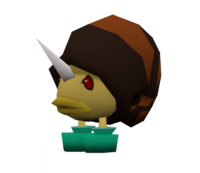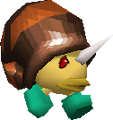Snailicorn
| Snailicorn | |||
|---|---|---|---|
 Model from New Super Mario Bros. | |||
| Appears in | New Super Mario Bros. (2006) | ||
| |||
Snailicorns[1] are large snail-like enemies in New Super Mario Bros. Their name is a portmanteau of "snail" and "unicorn." Every Snailicorn has two small green feet and a horn on its head. Snailicorns appear only in World 5-3 and World 5-B. A Snailicorn walks straightforward on the platform it is on and turns around to avoid edges if necessary, similarly to red Koopa Troopas. If a Snailicorn sees Mario or Luigi, it charges in a straight line with its horn facing him. Jumping on a Snailicorn's shell pushes it backward, possibly into gaps within platforms or bottomless pits, and ground-pounding a Snailicorn pushes it even farther back. Snailcorns can be defeated from either Shell Mario's Shell Dash move, a Mega Mushroom, or a Starman.
The game's internal filename for "Snailicorn" is a romanization of the Japanese name for "Bully," suggesting that it was originally designed as one before being changed to a horned snail.[2] This explains why the two species act in a similar manner. Given that it has one horn and appears only in ice levels, it may have specifically been modeled after the Chill Bully.
Gallery[edit]
Naming[edit]
Internal names[edit]
| Game | File | Name | Meaning
|
|---|---|---|---|
| New Super Mario Bros. | data/enemy/donketu.nsbmd | donketu | Bully |
Names in other languages[edit]
The contemporaneous name for each language is listed first. Subsequent names are listed in chronological order for each language, from oldest to newest, and have the media with which they are associated in the "notes" column. Names exclusive to localizations of the Super Mario Bros. Encyclopedia are not prioritized due to concerns about circular reporting, and are only listed first for their respective languages if they are the only ones available.
| Language | Name | Meaning | Notes |
|---|---|---|---|
| Japanese | トゲツムリ[3][4][5] Togetsumuri |
Portmanteau between「 |
|
| French | Snailicorn[6][7] | - | |
| Italian | TartaSpunzo[8] | Portmanteau of tartaruga ("turtle") and Spunzo ("Spike") | |
| Spanish | Caracol Spike[9] | Spike Snail |
References[edit]
- ^ Loe, Casey (May 15, 2006). New Super Mario Bros. Player's Guide. Nintendo of America (American English). ISBN 1-59812-009-3. Page 12.
- ^ TCRF. New Super Mario Bros. § Internal Names. The Cutting Room Floor (English). Retrieved June 3, 2024.
- ^ Watanabe, Takashi, Geesen Ueno, Noriko Oketani, Tatsuhiko Mizutani, Yoshimori Kato, Mizuho Nitta, Chie Maruyama, Junko Fukuda, and Kunio Takayama, editors (2006). 『ニュー・スーパーマリオブラザーズ: 任天堂公式ガイドブック』. Tokyo: Shogakukan (Japanese). ISBN 4-091063-07-1. Page 19.
- ^ Kashima, Aya, Daisuke Kitayama, Itaru Nakatani, Seishiro Fuwa, Isamu Horie, and Yoji Watanabe (2006). 『ニュー・スーパーマリオブラザーズ』. Tokyo: ambit (Japanese). ISBN 4-8399-2000-1. Page 15.
- ^ Sakai, Kazuya (ambit), kikai, Akinori Sao, Junko Fukuda, Kunio Takayama, and Ko Nakahara (Shogakukan), editors (2015). "New Super Mario Bros." in『スーパーマリオブラザーズ百科: 任天堂公式ガイドブック』. Tokyo: Shogakukan (Japanese). ISBN 978-4-09-106569-8. Page 114.
- ^ Loe, Casey (2006). New Super Mario Bros., le guide de stratégie officiel. Hamburg: Future Press (French). ISBN 3-937336-61-3. Page 12.
- ^ Ardaillon, Joanna, and Victoria Juillard-Huberty, editors (2018). "New Super Mario Bros." in Super Mario Encyclopedia. Translated by Fabien Nabhan. Toulon: Soleil Productions (French). ISBN 978-2-3020-7004-2. Page 114.
- ^ Sakai, Kazuya (ambit), kikai, Akinori Sao, Junko Fukuda, Kunio Takayama, Ko Nakahara (Shogakukan), and Marco Figini, editors (2018). "New Super Mario Bros." in Super Mario Bros. Enciclopedia. Translated by Marco Amerighi. Milan: Magazzini Salani (Italian). ISBN 889367436X. Page 114.
- ^ Sakai, Kazuya (ambit), kikai, Akinori Sao, Junko Fukuda, Kunio Takayama, and Ko Nakahara (Shogakukan), editors (2017). "New Super Mario Bros." in Enciclopedia Super Mario Bros. 30ª Aniversario. Translated by Gemma Tarrés. Barcelona: Editorial Planeta, S.A. (European Spanish). ISBN 978-84-9146-223-1. Page 115.


